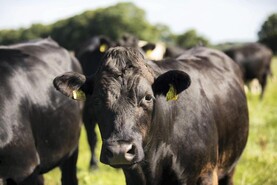Breeding: Most spring-calving farmers have started, or are about to start, the breeding season. The early spring this year shouldn’t sway your breeding start date too much. Higher-stocked and compact-calving farms shouldn’t be calving too early, even on dry land. There’s a lot of talk about bull selection and using more beef bulls to produce beefier calves, all for valid reasons.
However, we still need to breed efficient cows and I fear that this message may have been lost in the debate. Kilos of milk solids produced per kilo of cow liveweight is a very good measure of efficiency. The target should be to do 1:1 from a maximum of 10% of the total diet in meal.
So a 450kg cow should produce 450kg of milk solids from at most 540kg of meal. Larger cows are less efficient as they use proportionately more feed for maintenance meaning you need to stock them lighter, or buy in more feed. There are plenty of herds with larger cows doing 1kgMS per 1kgLWT, but most are feeding over 20% of the diet in the form of meal, which is neither efficient, profitable nor environmentally friendly.
The point here is that we don’t want to be breeding very small cows as they are bad for the beef industry, but neither do we want to be breeding large cows as they are bad for dairy farmers. The maintenance sub-index in EBI is a proxy for liveweight.
The higher the maintenance of the bull, the smaller the cow will be. I’d be slow to use bulls with a maintenance sub-index of less than €12.
Reseeding: We’re now in May and the country is awash with grass. Now is the time to take fields out for reseeding. Spray with glyphosate, leave for five to seven days after spraying and then graze or bale the field.
More farmers are opting to bale the burnt-off grass as it can be left to die back for longer than seven days and there’s a cleaner cut after the mower.
This is important when direct drilling as you don’t want too much trash at the surface.
Leaving the spray to work for longer is important when there are a lot of docks in the field. It takes two or three weeks for the spray to kill the dock roots.
It is a balancing act between giving the spray enough time to work and minimising the turn-around time between spraying off and having grass back in the field.
If there’s a weed problem in the field, my advice would be take a bit of time now to get it sorted.
Spraying: On the subject of spraying, now is the traditional time for spraying weeds under wires. I suppose the question is if this job is really necessary, particularly around hedgerows.
There has been a decline in the bee population and this can be linked back to a reduction in pollen-producing flowering plants.
Whatever about spot spraying under farm roadways and in fields, blanket spraying around hedgerows is excessive.
I know nettles can grow up and around wires, but a spot spray will fix that problem. Likewise, never spray along watercourses and rivers as weed sprays such as MCPA are extremely toxic to fish and aquatic life.






 This is a subscriber-only article
This is a subscriber-only article










SHARING OPTIONS: